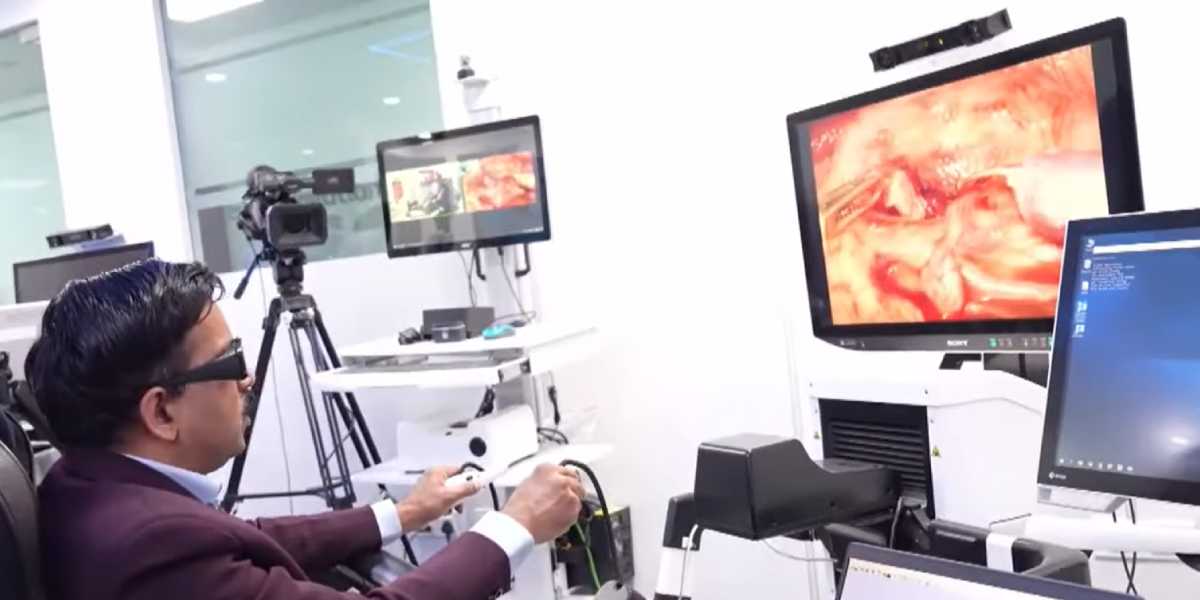A previous telesurgery in China involved an eight-year-old child, but this was the first on a 16-month-old.
Published Sep 20, 2025 | 7:00 AM ⚊ Updated Sep 20, 2025 | 7:00 AM

Telesurgery performed on a 16-month-old. (Supplied)
Synopsis: The baby needed surgery to widen the narrowed area and create a clear pathway for urine to flow from the kidney through the ureter to the bladder, restoring normal drainage and protecting kidney function. “Since the child was only 16 months old, we decided to opt for robotic surgery,” Dr. Chandramohan said. He controlled the India-made SSI Mantra robotic system from Gurugram while the robot operated in Hyderabad.
In a medical achievement that bridges distance through technology, a Hyderabad-based surgeon successfully performed robotic surgery on a 16-month-old infant while sitting at a console 1,600 kilometers away in Gurugram, creating history as the world’s first telesurgery on such a young patient from this far.
Dr Chandra Mohan, Chief Urologist at Preethi Kidney Hospital, sat at a console in the SSI Mantra office in Gurugram twelve days ago and controlled a robot performing surgery in Hyderabad. The baby was discharged the next day.
The infant was born with ureteropelvic obstruction, a condition where the junction between the kidney and the tube that carries urine becomes narrowed or blocked. The renal pelvis acts as a funnel-shaped collecting area inside the kidney where urine gathers before flowing into the ureter, a thin tube that carries urine down to the bladder.
When this junction is obstructed, urine backs up in the kidney like water behind a dam, causing the kidney to swell and potentially leading to permanent damage if left untreated.
The blockage can be caused by abnormal development of the ureter during pregnancy, creating either a narrow segment or a kink that prevents normal urine flow. In this baby’s case, urine produced by the kidney could not drain properly, creating pressure that threatened the organ’s function.
The baby needed surgery to widen the narrowed area and create a clear pathway for urine to flow from the kidney through the ureter to the bladder, restoring normal drainage and protecting kidney function.
“Since the child was only 16 months old, we decided to opt for robotic surgery,” Dr. Chandramohan said. He controlled the India-made SSI Mantra robotic system from Gurugram while the robot operated in Hyderabad.
Using 5G connectivity and the SSI Mantra system, Dr Chandramohan operated remotely. The surgery lasted one hour and twenty minutes. This was the first cross-state telesurgery in India.
A previous telesurgery in China involved an eight-year-old child, but this was the first on a 16-month-old.
Meanwhile, Dr Chandramohan performed another telesurgery on a woman in Moradabad, Uttar Pradesh. She had urinary leakage after a hysterectomy. Local surgeons only knew open procedures and contacted Preeti Hospital for help.
Dr Chandramohan operated the robot’s arms from Gurugram while watching video feeds from Hyderabad and Moradabad. The 5G connection transmitted his hand movements to the robot without delay. The robot copied his motions inside the patients.
Dr Chandramohan said the Indian system costs half the price of western robots. The doctor further added that he wants to train junior doctors in different locations so poor and middle-class patients can afford tele-robotic surgery.
“India is a vast country, and it is not possible to have top-level specialists in every corner,” Dr Chandramohan said. “If groups of doctors invest in surgical robots, experts from major centres can operate remotely.”
One console can connect with up to ten robots at once. This helps patients and teaches local doctors. The procedures require government permission.
Dr Chandramohan believes telesurgery will expand across India. “Robots cost less than bringing specialists to every city. Training programs can teach local doctors to assist with remote procedures,” he said, adding, “The SSI Mantra system was developed in India. Using Indian technology for Indian patients reducing costs and dependence on foreign equipment.”
The woman in Moradabad needed surgery that local doctors could not perform. The baby in Hyderabad required delicate work on blocked kidneys. In both cases, distance separated patients from the surgeon they needed.
However, patients avoided traveling long distances, as the robot brought the surgeon’s skills to them instead.
The baby’s kidney blockage prevented normal urine flow. Without surgery, the condition could damage the kidney permanently. The robot made precise cuts and removed the obstruction. The baby’s urine now flows normally. The hospital also said that the 16-month-old patient went home one day after surgery.
The woman’s hysterectomy had damaged her urinary system. She leaked urine constantly. The robot repaired the damage through small incisions. She recovered without complications.
Dr Chandramohan said patients cooperated well with the procedures. The hospital teams in both cities worked together despite the distance.
The surgeries prove that location no longer limits access to specialist care. A surgeon in one city can operate in another through robotic systems and fast internet connections.
(Edited by Sumavarsha)
